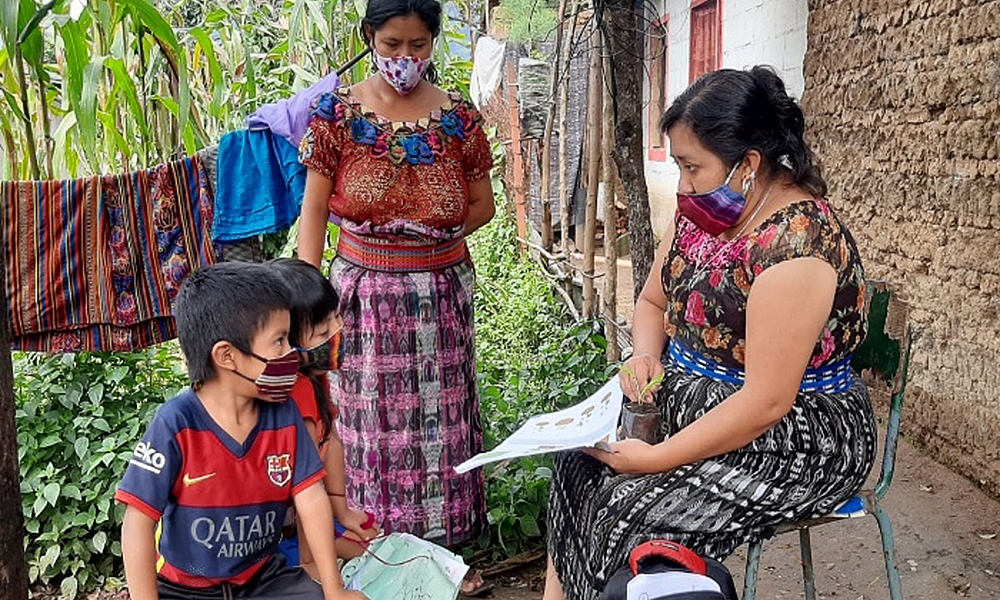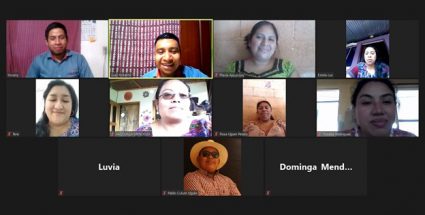
Teacher Teresa Azucena González Tuch hasn’t let the COVID-19 crisis get in the way of helping her students continue learning.
Each Tuesday and Thursday, Teresa visits her kindergarten students in their homes around the community of San Pablo la Laguna to check in and provide support. She brings new assignments and worksheets and picks up completed work. She provides additional instruction to children who are struggling and talks with parents about the assignments and how they can assist their children.
“The children are always happy to see their teacher,” she says. “And without a doubt, parents are very grateful and satisfied to see their children learning and doing their homework.”
Although schools have been closed in Guatemala since March and will remain closed through the end of the year, Child Aid teachers like Teresa have stayed connected with their students and helped them continue learning during this difficult time. For Teresa, this has been possible thanks to her dedication to her students and the online teacher training and support she’s received from Child Aid’s literacy team.
The challenges of teaching students during Covid-19
Since the beginning of the school shutdown, the Guatemalan Ministry of Education has instructed schools and teachers to turn to online tools to continue teaching students. However, the “digital divide” between access-rich cities in Guatemala and smaller, less digitally connected communities is stark.
Many of the government-provided educational materials produced for students require internet-enabled smartphones, tablets or computers. And only a tiny minority of families where Child Aid works have such access. Teachers said using the distance learning curriculum was simply not possible where they taught.
When her school closed, Teresa says she worried that quarantine would have a very negative effect on her student’s progress and learning. On her own initiative, Teresa set up a WhatsApp group for her class where she is able to text with parents and send them resources like worksheets for their children. She also gave some classes by video call, doing read-alouds with her students. “The stories are what the children like best,” she says.
But Theresa soon realized that this form of distance learning was not working for many of her students. Some did not have smart phone or internet access to participate. Others struggled to understand the lessons on their own and were falling behind. That’s when Teresa decided to ask parents for permission to visit the students at home to give them one-on-one support and encouragement.
Adapting our online training to teachers’s most pressing needs
Early on, the Child Aid literacy team recognized that teachers would need extra support during the school shutdown. So the Child Aid team adapted the workshops to host them online through Zoom and WhatsApp and modified the content to meet the teachers’ most pressing needs.

Without classroom instruction time and limited access with students, teachers need basic tools that can help them stay connected with their students and provide meaningful learning opportunities. We are helping teachers create simple worksheets for students that are easier for kids and parents to use. For example, students are creating book reviews of their favorite recently-read books; mapping out the plot of stories; reading passages about history and science and reflecting on their new learnings, and making inferences about new characters they are meeting.
The response from teachers to Child Aid’s online teacher training has been surprisingly enthusiastic and strong. The teachers have been excited to participate and grateful for the new strategies and resources. “You always have something up your sleeve to help us,” said one teacher during a workshop. Attendance rates have been close to full participation and after each training, teachers have been eagerly setting up their coaching sessions with our trainers for more individualized support in creating their student materials.
Teresa says that the support and encouragement has been a big help to her and she appreciates Child Aid’s practical, problem-solving approach, especially during this challenging time.